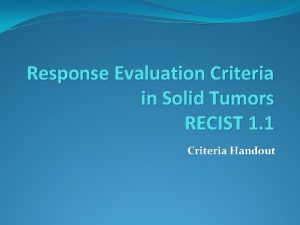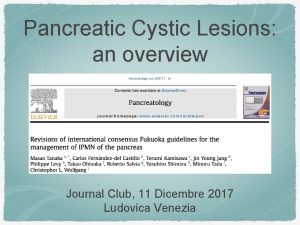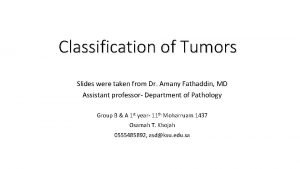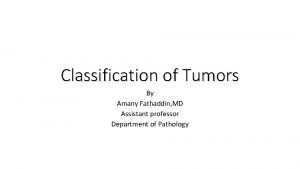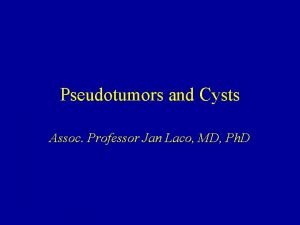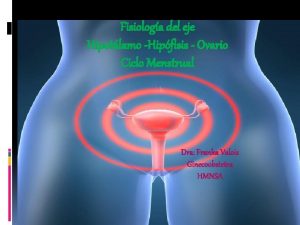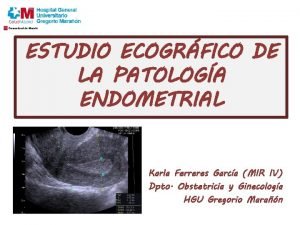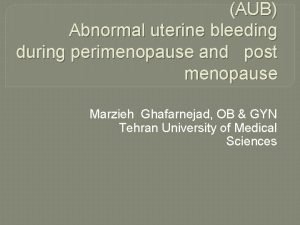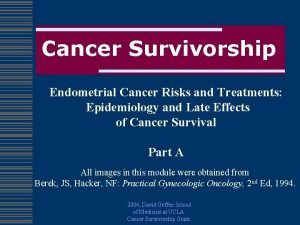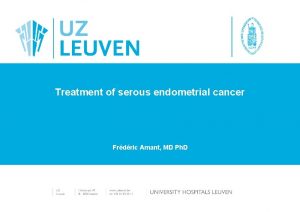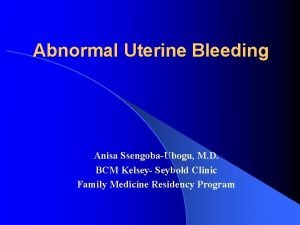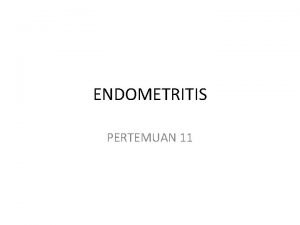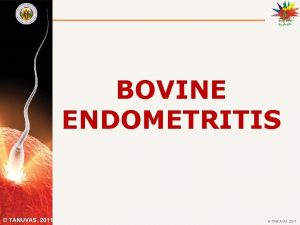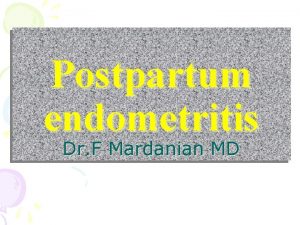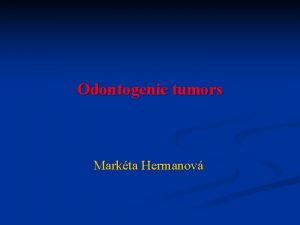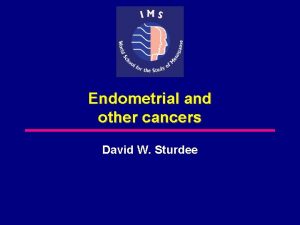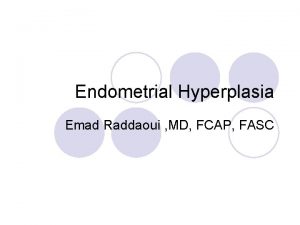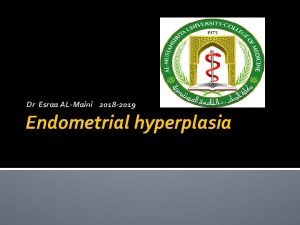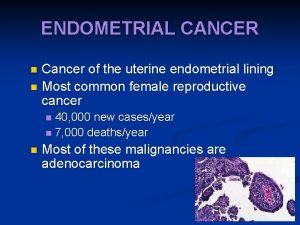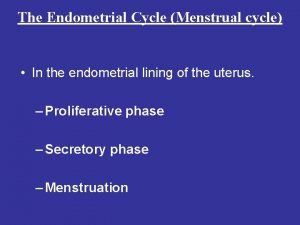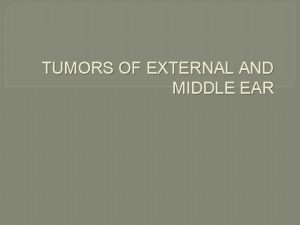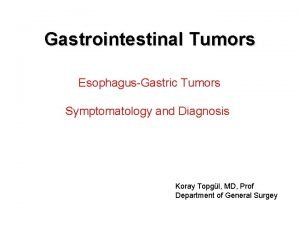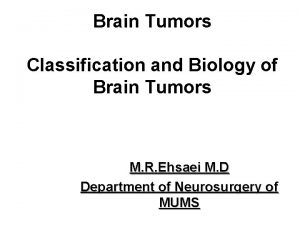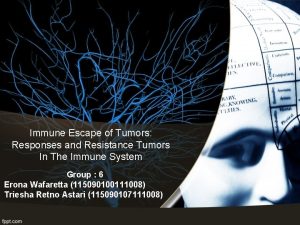Endometritis and endometrial tumors Dr farhana zakaria Endometrial


































- Slides: 34

Endometritis and endometrial tumors Dr. farhana zakaria

Endometrial Polyps • Endometrial polyps are exophytic masses of variable size that project into the endometrial cavity. • They may be single or multiple and are usually sessile, measuring from 0. 5 to 3 cm in diameter, but are occasionally large and pedunculated.

• Polyps may be asymptomatic or may cause abnormal bleeding (intramenstrual, menometrorrhagia, or postmenopausal) if they ulcerate or undergo necrosis. Most commonly the glands within polyps are hyperplastic or atrophic, but they can occasionally demonstrate secretory changes (functional polyps).

• Hyperplastic polyps may develop in association with generalized endometrial hyperplasia and are responsive to the growth effect of estrogen but show little or no progesterone response. • Atrophic polyps, which largely occur in postmenopausal women, most likely represent atrophy of a hyperplastic polyp. • Rarely, adenocarcinomas arise within endometrial polyps. • Endometrial polyps have been observed in association with the administration of tamoxifen which is often used in therapy of breast cancer due to its anti-estrogenic activity on the breast

Endometritis • The endometrium and myometrium are relatively resistant to infections, primarily because the endocervix normally forms a barrier to ascending infection

ACUTE ENDOMETRITIS • Acute endometritis is uncommon and limited to bacterial infections that arise after delivery or miscarriage. • Retained products of conception are the usual predisposing influence; the causative agents include group A hemolytic streptococci, staphylococci, and other bacteria. • The inflammatory response is chiefly limited to the interstitium and is entirely nonspecific

CHRONIC ENDOMETRITIS • Chronic inflammation of the endometrium occurs in the following settings: • (1) in patients suffering from chronic PID; • (2) in postpartum or post-abortion patients with retained gestational tissue; • (3) in women with intrauterine contraceptive devices; and • (4) in women with tuberculosis, either from miliary spread or, more commonly, from drainage of tuberculous salpingitis

• In about 15% of cases no cause is obvious, yet plasma cells (which are not present in normal endometrium) are seen together with macrophages and lymphocytes. • Some women with this so-called nonspecific chronic endometritis have gynecologic complaints such as abnormal bleeding, pain, discharge, and infertility. • Chlamydia may be involved and is commonly associated with both acute (e. g. , polymorphonuclear leukocytes) and chronic (e. g. , lymphocytes, plasma cells) inflammatory cell infiltrates. • The organisms may or may not be successfully cultured.

Malignant Tumors of the Endometrium • CARCINOMA OF THE ENDOMETRIUM • Endometrial carcinoma is the most common invasive cancer of the female genital tract and accounts for 7% of all invasive cancer in women • Endometrial cancers arise mainly in postmenopausal women. • Because they cause abnormal (postmenopausal) bleeding, early detection and cures are possible.

Molecular Pathogenesis • Carcinoma of the endometrium is uncommon in women younger than 40 years of age. • The peak incidence is in 55 - to 65 -year-old women. • Clinicopathologic studies and molecular analyses support the classification of endometrial carcinoma into two broad categories, referred to as type I and type II

Type I carcinomas • These are the most common type, accounting for greater than 80% of all cases. • Majority are well differentiated and mimic proliferative endometrial glands and, as such, are referred to as endometrioid carcinoma. • They typically arise in the setting of endometrial hyperplasia and like endometrial hyperplasia they are associated with

• (1) obesity, • (2) diabetes (abnormal glucose tolerance is found in more than 60%), • (3) hypertension, • (4) infertility (women who develop cancer of the endometrium tend to be nulliparous and have a history of functional menstrual irregularities consistent with anovulatory cycles), and • (5) unopposed estrogen stimulation.

• Mutations in the PTEN tumor suppressor gene have been identified in 30% to 80% of endometrioid carcinomas and in approximately 20% of endometrial hyperplasias, both with and without atypia.

Morphology • On gross inspection, endometrial carcinoma can be either a localized polypoid tumor or a diffuse tumor involving the endometrial surface. • Spread generally occurs by direct myometrial invasion with eventual extension to the periuterine structures by direct continuity. • Spread into the broad ligaments may create a palpable mass. • Dissemination to the regional lymph nodes eventually occurs, and in the late stages, the tumor may metastasize to the lungs, liver, bones, and other organs.

• On histologic examination, most endometrial carcinomas (about 85%) are endometrioid adenocarcinomas characterized by gland patterns resembling normal endometrial epithelium. • A three-step grading system is applied to endometrioid tumors and includes

• Well differentiated (grade 1) , with easily recognizable glandular patterns; • Moderately differentiated (grade 2) , showing well-formed glands mixed with solid sheets of malignant cells; • Poorly differentiated (grade 3) , characterized by solid sheets of cells with barely recognizable glands and a greater degree of nuclear atypia and mitotic activity.

• G 1. Well-differentiated adenocarcinoma, less than 5% solid growth • G 2. Moderately differentiated adenocarcinoma with partly (less than 50%) solid growth • G 3. Poorly differentiated adenocarcinoma with predominantly solid growth (greater than 50%)

• Up to 20% of endometrioid carcinomas contain foci of squamous differentiation. • Squamous elements may be histologically benign-appearing when they are associated with well-differentiated adenocarcinomas. • Less commonly, moderately or poorly differentiated endometrioid carcinomas contain squamous elements that appear frankly malignant

Type II carcinomas • These generally occur in women a decade later than type I carcinoma, and in contrast to type I carcinoma they usually arise in the setting of endometrial atrophy. • Type II tumors are by definition poorly differentiated (grade 3) tumors and account for approximately 15% of cases of endometrial carcinoma. • The most common subtype is serous carcinoma, referred to as such because of morphologic and biologic overlap with ovarian serous carcinoma

• There are less common histologic subtypes (clear cell carcinoma and malignant mixed müllerian tumor) within this category, but very little is known about their pathogenesis. • The most frequent alteration described in serous endometrial carcinoma is mutation of the p 53 tumor suppressor gene.

• The precursor of serous carcinoma, endometrial intraepithelial carcinoma (EIC), consists of cells identical to those of serous carcinoma but lacks identifiable stromal invasion. • Mutations in p 53 are found in approximately 75% of these lesions, suggesting that mutation of p 53 is an early event in serous endometrial carcinoma

Morphology • Generally, serous carcinomas arise in small atrophic uteri and are often large bulky tumors or deeply invasive into the myometrium. • The precursor lesion, endometrial intraepithelial carcinoma, consists of malignant cells identical to those of serous carcinoma but they remain contained to the gland surface without identifiable stromal invasion.

• The invasive lesions may have a papillary growth pattern composed of cells with marked cytologic atypia including high nuclear-to-cytoplasmic ratio, atypical mitotic figures, heterochromasia, and prominent nucleoli

• They can also have a predominantly glandular growth pattern that can be distinguished from endometroid carcinoma by the marked cytologic atypia. • All of the non-endometrioid carcinomas are classified as grade 3 irrespective of histologic pattern.

Clinical Course • Asymptomatic for a period of time • it usually produces irregular or postmenopausal vaginal bleeding with excessive leukorrhea. • Uterine enlargement may be absent in the early stages. • The diagnosis of endometrial cancer must ultimately be established by biopsy or curettage and histologic examination of the tissue.

MALIGNANT MIXED MÜLLERIAN TUMORS • MMMTs (previously referred to as carcinosarcomas) consist of endometrial adenocarcinomas with malignant changes in the stroma. • The stroma tends to differentiate into a variety of malignant mesodermal components, including muscle, cartilage, and even osteoid.

• The epithelial and stromal components are presumably derived from the same cell • MMMTs occur in postmenopausal women and present with postmenopausal bleeding.

• Grossly , MMMTs are fleshier than adenocarcinomas, may be bulky and polypoid, and sometimes protrude through the cervical os. • On histology, the tumors consist of adenocarcinoma (endometrioid, serous, or clear cell) mixed with the malignant mesenchymal (sarcoma) elements ; alternatively, the tumor may contain two distinct and separate epithelial and mesenchymal components.

• Sarcomatous components may also mimic extrauterine tissues (e. g. , striated muscle, cartilage, adipose tissue, and bone). Metastases usually contain only epithelial components

• Outcome of MMMTs is determined primarily by depth of invasion and stage. • As with endometrial carcinomas, the prognosis is influenced by the grade and type of the adenocarcinoma, being poorest with serous differentiation

Tumors of the Endometrium with Stromal Differentiation • These are relatively uncommon tumors and comprise less than 5% of endometrial cancers. • One group is composed of stromal neoplasias in association with benign glands (adenosarcomas). • The other group consists of pure stromal neoplasms, ranging from benign (stromal nodule) to malignant (stromal sarcoma

ADENOSARCOMAS • Adenosarcomas present most commonly as large broad-based endometrial polypoid growths that may prolapse through the cervical os • The diagnosis is based on malignant-appearing stroma, which coexists with benign but abnormally shaped endometrial glands. • These tumors predominate in women between the fourth and fifth decades and are generally considered to be a low-grade malignancy; recurrences develop in one fourth and are nearly always confined to the pelvis

STROMAL TUMORS • The endometrial stroma occasionally gives rise to neoplasms that may resemble normal stromal cells. • Similar to most neoplasms, they may be well or poorly differentiated. • Stromal neoplasms are divided into two categories: (1) benign stromal nodules and (2) endometrial stromal sarcomas

• Stromal nodule is a well-circumscribed aggregate of endometrial stromal cells in the myometrium that does not penetrate the myometrium and is of little consequence. • Stromal sarcoma consists of neoplastic endometrial stroma lying between muscle bundles of the myometrium and is distinguished from stromal nodules by either diffuse infiltration of myometrial tissue or the invasion of lymphatic channels (previously termed endolymphatic stromal myosis).
 Puerperal sepsis definition
Puerperal sepsis definition Farhana zulkernine
Farhana zulkernine Fareed zakaria american dream
Fareed zakaria american dream Saharzakaria
Saharzakaria Dr alan zakaria
Dr alan zakaria Zakaria chowdhury
Zakaria chowdhury Ethnography synonym
Ethnography synonym Zakaria abdulla
Zakaria abdulla Malignant and benign tumors
Malignant and benign tumors Benign and malignant tumors
Benign and malignant tumors Teratoma
Teratoma Cervical stenosis cervix
Cervical stenosis cervix Response evaluation criteria in solid tumors (recist)
Response evaluation criteria in solid tumors (recist) Triangle de codman
Triangle de codman Exostosis
Exostosis Anterior ramus of spinal cord
Anterior ramus of spinal cord Brain tumors
Brain tumors Acromely
Acromely Paresthiasis
Paresthiasis Intraductal papillary mucinous neoplasm
Intraductal papillary mucinous neoplasm Local invasion
Local invasion Classification of tumors
Classification of tumors Odontogenic tumors classification
Odontogenic tumors classification Enneking classification
Enneking classification Odontogenic tumors
Odontogenic tumors Ameloblastoma rtg
Ameloblastoma rtg Ata thyroid
Ata thyroid Hipotlamo
Hipotlamo Grosor normal del endometrio
Grosor normal del endometrio Postmenopausal endo thickness
Postmenopausal endo thickness Endometrial cells
Endometrial cells Endometrial hyperplasia
Endometrial hyperplasia Endometrial cancer
Endometrial cancer Endometrial cancer
Endometrial cancer Endometrial adenocarcinoma
Endometrial adenocarcinoma












